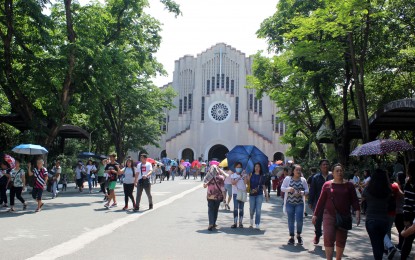
Baclaran Church (File photo)
MANILA – The Inter-Agency Task Force for the Management of Emerging Infectious Diseases (IATF-EID) has allowed mass gatherings for religious purposes to partially resume in areas placed under general community quarantine, Malacañang said on Friday.
Members of the IATF-EID, in a meeting held Thursday, agreed to allow the resumption of religious activities in GCQ zones but only at 10 percent seating capacity, Presidential Spokesperson Harry Roque said during the Laging Handa program aired on state-run PTV-4.
Roque said the latest order, which will take effect on July 10, was contained in Resolution 51 approved by the IATF-EID on Thursday.
“Para naman po sa talagang gusto nang magsimba, pinayagan din po ang religious gatherings pero hanggang 10 percent lang po. At ito po ay epektibo sa July 10, 2020 sa areas na GCQ (For those who really want to attend mass, religious gatherings are now allowed but only at 10 percent capacity. This is effective on July 10, 2020, for areas under GCQ),” he said.
The IATF-EID initially issued guidelines in May, which permit the conduct of religious gatherings in areas under MGCQ and GCQ, provided that the number of participants is limited to only five and 10, respectively.
In June, the IATF-EID approved Resolution 43, which authorizes religious services at “50 percent of the seating capacity” in places under MGCQ.
Roque said mass gatherings for religious purposes in areas put under MGCQ remain allowed, so long as participants are limited to 50 percent of the venue capacity.
He reminded the public anew to observe strict social distancing and use a face mask when they go to church.
“Importante po na sundin natin ang mga minimum public health standards tulad ng social distancing, pagsusuot ng face mask, at iba pa (It’s important to follow minimum public health standards, such as social distancing and use of face mask, among others),” Roque said.
The IATF-EID relaxed its quarantine rules in June when it allowed more industries to reopen to enable the country to recover from the coronavirus disease 2019 (Covid-19) crisis.
Only Cebu City was placed under enhanced community quarantine, the most stringent community quarantine, until July 15 due to the continuing increase in the number of Covid-19 infections in the area.
The GCQ was implemented in Metro Manila, Benguet, Cavite, Rizal, Lapu-Lapu City, Mandaue City, Ormoc, Leyte, Southern Leyte, and Cebu’s Talisay City, Minglanilla, and Consolacion.
The MGCQ with “strict local action” was imposed in Abra, Baguio City, Ifugao, Kalinga, Ilocos Norte, La Union, Pangasinan, Cagayan, Isabela, Bataan, Bulacan, Nueva Ecija, Pampanga, Angeles City, Batangas, Laguna, Quezon, Lucena City, Palawan, Puerto Princesa City, Albay, Camarines Norte, Camarines Sur, and Naga City.
Capiz, Iloilo City, Negros Occidental, Bacolod City, Cebu province, Bohol, Negros Oriental, Tacloban City, Western Samar, Zamboanga City, Zamboanga del Sur, Bukidnon, Misamis Occidental, Misamis Oriental, and Cagayan de Oro were also placed under stricter MGCQ.
MGCQ with “strict local action” was likewise implemented in Davao del Norte, Davao del Sur, Davao City, Davao de Oro, Cotabato, South Cotabato, Agusan del Norte, Butuan City, Lanao del Sur, and Maguindanao.
The rest of the country is under a more relaxed MGCQ. (PNA)
